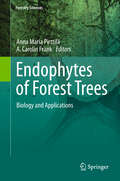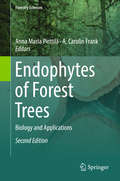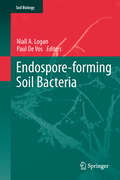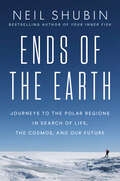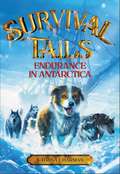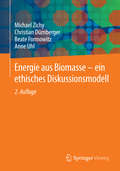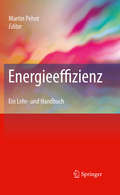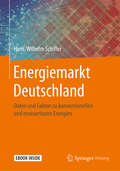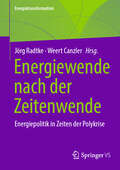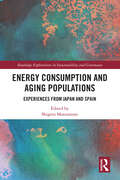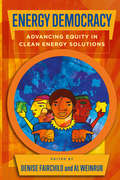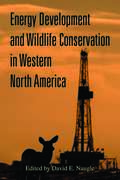- Table View
- List View
Endlessly Green
by Savita HiremathEndlessly Green looks at the history, the science and the art of composting and sustainable waste management through a kaleidoscope of philosophical, moral and ethical intricacies. The author digs into her rich pool of experiential learnings and raw inputs gathered through a decade of research, legwork and fearless execution. This engaging field guide equips community volunteers, activists, students, SWM practitioners and professionals with practical inputs on segregation, composting and organic gardening/farming, making sustainability imaginable in a concrete jungle. In doing so, it helps individuals discover the possibilities of bringing about a change in their environment by engaging their own environmental sensibilities. Endlessly Green is an extraordinary celebration of things small and significant and the fight against waste, culminating in a replicable and scalable end-to-end solution.
Endlings: Fables for the Anthropocene (Forerunners: Ideas First)
by Lydia PyneAmid the historical decimation of species around the globe, a new way into the language of loss An endling is the last known individual of a species; when that individual dies, the species becomes extinct. These &“last individuals&” are poignant characters in the stories that humans tell themselves about today&’s Anthropocene. In this evocative work, Lydia Pyne explores how discussion about endlings—how we tell their histories—draws on deep traditions of storytelling across a variety of narrative types that go well beyond the science of these species&’ biology or their evolutionary history.Endlings provides a useful and thoughtful discussion of species concepts: how species start and how (and why) they end, what it means to be a &“charismatic&” species, the effects of rewilding, and what makes species extinction different in this era. From Benjamin the thylacine to Celia the ibex to Lonesome George the Galápagos tortoise, endlings, Pyne shows, have the power to shape how we think about grief, mourning, and loss amid the world&’s sixth mass extinction.
Endophytes of Forest Trees
by Anna Maria Pirttilä A. Carolin FrankFound in every plant species, the diversity of endophytic micro-organisms can be extremely high within different plant organs and tissue types. In trees, their ecological roles with respect to host tree can vary from latent pathogens or saprophytes to neutral commensalists and mutualists. Given their high diversity, and their bio-active nature, endophytes are currently being associated with a role in tree health against insect herbivores and fungal pathogens, as well as improving tree properties in phytoremediation. Meanwhile there is increasing interest in the potential of some tree endophytes as new sources of drug compounds. The first book on tree endophytes in several years, and containing contributions from leading authors in the field, this book provides an important reference text for professional researchers and advanced students.
Endophytes of Forest Trees: Biology and Applications (Forestry Sciences #86)
by Anna Maria Pirttilä A. Carolin FrankEndophytes are commonly known as microorganisms, mainly bacteria and fungi, which live inside plant tissues without inducing symptoms. Considering the long-lived trees, endophytes have a fundamental role in preparing their hosts to face extreme weather conditions, drought, heat, cold, and pathogen and herbivore attacks. The current knowledge clearly demonstrates the importance of endophytes in shaping the plant diversity in a forest. Endophytes have an important capacity for biocontrol of forest diseases. Considering endophyte diversity and the range of various compounds and enzymes they can produce, endophytes can be used for various biotechnological applications.
Endospore-forming Soil Bacteria
by Paul De Vos Niall A. LoganAerobic endospore-forming bacteria are found in soils of all kinds, ranging from acid to alkaline, hot to cold, and fertile to desert. It is well known that endospores confer special properties upon their owners and play dominant parts in their life cycles and dispersal, and much has been written about the spores, genetics, and economic importance of these organisms. Much has also been written about soil ecology, but there is a relative dearth of literature that brings together different aspects of the behaviour and characters of endospore-formers with their contributions to soil ecosystems. This Soil Biology volume fills that gap. Following chapters that describe the current classification of these organisms, that review methods for their detection and for studying their life cycles in soils, and that examine their dispersal, other chapters show that they are active and dynamic members of soil floras that interact widely with other soil inhabitants, with roles in nitrogen fixation, denitrification, and soil remediation.
Endowed: Regulating the Male Sexed Body
by Michael ThomsonFeminist legal scholars and health care lawyers have long engaged with law’s responses to the female reproductive body, especially on what the legal regulation of women’s reproductive lives can tell us about the broader relationship between law and gender. Acknowledging this work and building upon it, Endowed considers the interaction of law and ideas of male reproductivity. In particular, it seeks to uncover what these regulatory moments can tell us about contemporary ideas and ideals of masculinity and the male sexed body. Spanning topics such as male circumcision and the regulation of state access to Viagra, the book uncovers recurring motifs that define masculinity and the male body in the legal imagination. In looking to these understandings the book engages with broader questions regarding the relationship between law and gender and between masculinity and social organization.
Ends of the Earth: Journeys to the Polar Regions in Search of Life, the Cosmos, and Our Future
by Neil ShubinThe bestselling author of Your Inner Fish takes readers on an epic adventure to the North and South Poles to reveal the secrets locked in the ice about life, the cosmos, and our planet&’s future. Renowned scientist Neil Shubin has made extraordinary discoveries by leading scientific expeditions to the sweeping ice landscapes of the Arctic and Antarctic. He&’s survived polar storms, traveled in temperatures that can freeze flesh in seconds, and worked hundreds of miles from the nearest humans, all to deepen our understanding of our world. Written with infectious enthusiasm and irresistible curiosity, Ends of the Earth blends travel writing, science, and history in a book brimming with surprising and wonderful discoveries. Shubin retraces his steps on a &“dinosaur dance floor,&” showing us where these beasts had populated the once tropical lands at the poles. He takes readers meteor hunting, as meteorites preserved in the ice can be older than our planet and can tell us about our galaxy&’s formation. Readers also encounter insects and fish that develop their own anti-freeze, and aquatic life in ancient lakes hidden miles under the ice that haven&’t seen the surface in centuries. It turns out that explorers and scientists have found these extreme environments as prime ground for making scientific breakthroughs across a vast range of knowledge. Shubin shares unforgettable moments from centuries of expeditions to reveal just how far scientists will go to understand polar regions. In the end, what happens at the poles does not stay in the poles—the ends of the earth offer profound stories that will forever change our view of life and the entire planet.
Ends of the Earth: Journeys to the Polar Regions in Search of Life, the Cosmos, and our Future
by Neil ShubinFrigid, remote and inhospitable – the polar regions seem far removed from our everyday lives. But these seemingly isolated ice realms shape life on our planet far more than we realise, influencing everything from the climate to ocean health. They may even hold the secrets to the origins of the Earth. Taking an epic journey of discovery from pole-to-pole, ferrying between penguins and polar bears, Ends of the Earth reveals the polar regions as never before. Meeting with the leading physicists, climatologists, geologists, biologists and palaeontologists working in these extremes – often as eccentric as they are intrepid – Neil Shubin presents the compelling new science of the Arctic and Antarctic with characteristic verve and expertise.
Endurance in Antarctica (Survival Tails #2)
by Katrina CharmanA group of sled dogs race to survive a perilous journey across Antarctica in the exhilarating second installment of Survival Tails, perfect for fans of the Ranger in Time and I Survived series! <P><P>Sled dog Samson wants nothing more than to be part of Ernest Shackleton's historic voyage to Antarctica. <P><P>He wants to feel the snow under his paws and the wind on his face as he races across the ice fields, and most of all he wants to help his humans find eternal glory as they chart the continent. His fellow sled dog, Bummer, just wants to get through the voyage in one piece. Why would he want to face down a dangerous, icy wasteland when he could stay inside his kennel, warm and safe? <P><P>When their ship, the Endurance, becomes trapped in sea ice, leaving the dogs and men with no way home, their journey becomes not about personal glory, but about survival. Samson, Bummer, and the other dogs will have to put aside their differences and band together to rescue their humans...and themselves. <P><P>With engaging nonfiction back matter that delves into the fascinating true story behind the book, Survival Tails: Endurance in Antarctica is sure to keep readers entertained as the second entry in this series of action-packed animal adventures.
Enduring Acequias: Wisdom of the Land, Knowledge of the Water (Querencias Series)
by Juan Estevan ArellanoFor generations the Río Embudo watershed in northern New Mexico has been the home of Juan Estevan Arellano and his ancestors. From this unique perspective Arellano explores the ways people use water in dry places around the world. Touching on the Middle East, Europe, Mexico, and South America before circling back to New Mexico, Arellano makes a case for preserving the acequia irrigation system and calls for a future that respects the ecological limitations of the land.
Enduring Patagonia
by Gregory CrouchPatagonia is a strange and terrifying place, a vast tract of land shared by Argentina and Chile where the violent weather spawned over the southern Pacific charges through the Andes with gale-force winds, roaring clouds, and stinging snow. Squarely athwart the latitudes known to sailors as the roaring forties and furious fifties, Patagonia is a land trapped between angry torrents of sea and sky, a place that has fascinated explorers and writers for centuries. Magellan discovered the strait that bears his name during the first circumnavigation. Charles Darwin traveled Patagonia's windy steppes and explored the fjords of Tierra del Fuego during the voyage of the Beagle. From the novel perspective of the cockpit, Antoine de Saint-Exupry immortalized the Andes in Wind, Sand, and Stars, and a half century later, Bruce Chatwin's In Patagonia earned a permanent place among the great works of travel literature. Yet even today, the Patagonian Andes remain mysterious and remote, a place where horrible storms and ruthless landscapes discourage all but the most devoted pilgrims from paying tribute to the daunting and dangerous peaks. Gregory Crouch is one such pilgrim. In seven expeditions to this windswept edge of the Southern Hemisphere, he has braved weather, gravity, fear, and doubt to try himself in the alpine crucible of Patagonia. Crouch has had several notable successes, including the first winter ascent of the legendary Cerro Torre's West Face, to go along with his many spectacular failures. In language both stirring and lyrical, he evokes the perils of every handhold, perils that illustrate the crucial balance between physical danger and mental agility that allows for the most important part of any climb, which is not reaching the summit, but getting down alive. Crouch reveals the flip side of cutting-edge alpinism: the stunning variety of menial labor one must often perform to afford the next expedition. From building sewer systems during a bitter Colorado winter to washing the plastic balls in McDonalds' playgrounds, Crouch's dedication to the alpine craft has seen him through as many low moments as high summits. He recounts, too, the riotous celebrations of successful climbs, the numbing boredom of forced encampments, and the quiet pride that comes from knowing that one has performed well and bravely, even in failure. Included are more than two dozen color photographs that capture the many moods of this land, from the sublime beauty of the mountains at sunrise to the unrelenting fury of its storms. Enduring Patagonia is a breathtaking odyssey through one of the world's last wild places, a land that requires great sacrifice but offers great rewards to those who dare to challenge it.
Enemies at Every Turn: A John Pearce Adventure (John Pearce)
by David DonachieFree from jail, John Pearce is not free from the smugglers whose boat he stole. They want bloody revenge and are prepared to chase him to the ends of the earth to get it. The court martial papers that threaten to also damn Pearce are at risk due to the calculating schemes of Ralph Barclay. But the danger is only just beginning, for Pearce must undertake a dangerous mission in support of a massive revolt in the Vendée region of France. As high rebellious ambition turns to bloody disaster, Pearce faces real peril, climaxing in one of the greatest battles of the French Revolutionary Wars: the Glorious First of June.
Energetics of the Climate System (ISTE Invoiced)
by Herve Le Treut Mounia MostefaouiEnergetics of the Climate System is derived from a course taught by Hervé Le Treut, who has been delivering this lecture series for decades to students at institutions such as the École Normale Supérieure, École Polytechnique, and Sorbonne University, along with students from other international institutions. This book offers a comprehensive understanding of the intricate energetics driving the Earth’s climate system. The goal was not only to capture the depth and complexity of this subject, but also to preserve the pedagogical brilliance and unique storytelling style of Hervé Le Treut. This work stands as both a tribute to his remarkable contributions and a reflection of his passion for teaching, having mentored generations of climatologists, engineers, and economists, many of whom – including the co-author Mounia Mostefaoui – have greatly benefited from his guidance. The text retains elements of an oral presentation to evoke the professor’s distinctive voice and teaching approach. The book is structured into five chapters, each independent and deeply interconnected, and is complemented by an appendix of exercises to reinforce its material.
Energie aus Biomasse - ein ethisches Diskussionsmodell
by Michael Zichy Christian Dürnberger Beate Formowitz Anne UhlEnergie aus Biomasse wird auf politischer, wissenschaftlicher und gesellschaftlicher Ebene höchst kontrovers diskutiert. – Dieses Buch liefert eine fundierte, klare und gut verständliche Analyse und Diskussion der ethischen und kulturell-emotionalen Aspekte von Energie aus Biomasse. Es diskutiert die Frage der Verantwortung und bringt naturwissenschaftliche und ethische Expertise in einen fruchtbaren Dialog. Vergleichende Fallstudien und Szenarien sorgen für die praktische Anbindung an die derzeitige landwirtschaftliche Praxis. Die zweite, überarbeitete Auflage bezieht sich auf die aktuellen gesetzlichen Rahmenbedingungen und berücksichtig die neuesten wissenschaftlichen Beiträge zum Diskurs, wie zum Beispiel zu indirekten Landnutzungsänderungen.
Energieeffizienz
by Martin PehntEnergieeffizienz und Energieeinsparung bilden - neben erneuerbaren Energien - die Säulen der zukünftigen Energiepolitik. Das Lehr- und Handbuch liefert das notwendige Wissen für eine effiziente Energieumwandlung und -nutzung von Strom, von Wärme und im Verkehr. Im Vordergrund steht das ingenieurtechnische Verständnis der jeweiligen Technologien, die Autoren vermitteln aber zugleich ökonomisches, sozialwissenschaftliches, umweltrechtliches und ökologisches Grundlagenwissen. Mit praxisnahen Übungsaufgaben und übersichtlichen Exkurs-Boxen.
Energiemanagement: Praxisbuch für Fachkräfte, Berater und Manager
by Marko Geilhausen Juliane Bränzel Dirk Engelmann Olaf SchulzeDas Buch stellt die Anforderungen der ISO 50001 als Grundlage für eine Zertifizierung dar. Dabei wird immer die Sicht des Energiemanagementbeauftragten im Auge behalten, indem praktische Hinweise für die Umsetzung und zu den einzelnen Normenpunkten gegeben werden. Die Änderungen zur Vorgängernorm DIN EN 16001 sind dargestellt und Möglichkeiten der Integration eines Energiemanagementsystems in bestehende Systeme nach ISO 9001 und ISO 14001 werden beschrieben. Damit bietet das Buch sowohl Neueinsteigern als auch Routiniers eine wertvolle Hilfe, die in Form dieses Enchiridions zur Verfügung steht.
Energiemarkt Deutschland: Daten und Fakten zu konventionellen und erneuerbaren Energien
by Hans-Wilhelm SchifferEnergiewirtschaftliche Entscheidungen und technische Weichenstellungen erfordern eine fundierte Datenbasis. Die wichtigsten Zahlen und Fakten zu deutschen und europäischen Energiemärkten (Mineralöl, Braunkohle, Steinkohle, Erdgas und Elektrizität), zu den Eigentumsverhältnisse von über 100 Energieunternehmen und Nachfrage- sowie Angebotsstrukturen sind in diesem Buch vermittelt. Es bietet sich als Nachschlagewerk und Einführung in die vielfältige Thematik an. Über 100 Tabellen und mehr als 200 Diagramme erleichtern den Zugang zu den umfangreichen Daten. Ein Glossar hilft dabei, Klarheit in die unterschiedlichen Begrifflichkeiten zu bekommen. Berater, Entscheider und an Kennzahlen interessierte Leser finden in diesem Buch umfangreiches Material für die eigene fachliche Fragestellung. Der Autor ist Executive Chair of the World Energy Resources Programme des World Energy Council, London. Er war viele Jahre in zwei Bundesministerien sowie in leitender Funktion bei einem großen Energieunternehmen tätig und ist Lehrbeauftragter in verschiedenen Masterstudiengängen an der RWTH Aachen.Aus dem Inhalt- Grundlagen der Energiewirtschaft- Struktur einzelner Energie-Teilmärkte- Erneuerbare Energien- Preisbildung in der Energiewirtschaft- Entwicklung der Energienachfrage- Klimaschutz und Emissionshandel- Perspektiven der Energieversorgung- Energiepolitik (Bundesebene)
Energiewende nach der Zeitenwende: Energiepolitik in Zeiten der Polykrise (Energietransformation)
by Weert Canzler Jörg RadtkeDer Überfall Russlands auf die Ukraine bedeutet eine Zeitenwende auch für die Energiepolitik. Die Abhängigkeit der Europäischen Union und Deutschlands von der fossilen Grundversorgung insbesondere mit Gas, aber auch mit Öl aus Russland wurde deutlich. Vor diesem Hintergrund behandelt dieser Band die folgenden vier Themen: Neue energiepolitische Governance, Allianzen, Policy-Strategien und Pfadabhängigkeiten zwischen fossilem und erneuerbarem Energieregime; Energiewirtschaftliche und energietechnische Probleme und Lösungen für eine beschleunigte Dekarbonisierung des Energiesektors; das Verhältnis zwischen zentraler und dezentraler Energiewende und die Rolle von Regulierung und Partizipation; Strategien der Kompensation und Beteiligungsmöglichkeiten von „Verlierern der Dekarbonisierung“ und von sozial besonders vulnerablen Teilen der Gesellschaft. Neben theoretisch-konzeptionellen und empirisch-vergleichenden Beiträgen werden internationale, supranationale, regionale und auch lokaleFallbeispiele im Band behandelt.
Energy & Ethics
by Benjamin K. SovacoolBenjamin K. Sovacool applies concepts from justice and ethics theory to contemporary energy problems, and illustrates particular solutions to those problems with examples and case studies from around the world.
Energy Access and Forced Migration (Routledge Studies in Energy Transitions)
by Owen GrafhamThis edited collection brings together a selection of expert authors and draws on a wide range of case studies, geographies, and perspectives to explore the links between forced migration and energy access. This book addresses the paucity of academic study on how energy is delivered to the millions of people currently forcibly displaced. The contributions throughout assess the current energy governance regimes, models of delivery, and innovative solutions that are dictating how energy is – and can be – provided to those who have been forced to move away from their homes. By bringing together author-teams of practitioners, academics, businesses, and policy makers, this collection encourages interdisciplinary dialogue about the best way of approaching energy provision for the forcibly displaced. This book will be of great interest to students and scholars of energy access and policy, environmental justice and equity, and migration and refugee studies.
Energy Analysis for a Sustainable Future: Multi-Scale Integrated Analysis of Societal and Ecosystem Metabolism
by Mario Giampietro Kozo Mayumi Alevgül H. ŞormanThe vast majority of the countries of the world are now facing an imminent energy crisis, particularly the USA, China, India, Japan and EU countries, but also developing countries having to boost their economic growth precisely when more powerful economies will prevent them from using the limited supply of fossil energy. Despite this crisis, current protocols of energy accounting have been developed for dealing with fossil energy exclusively and are therefore not useful for the analysis of alternative energy sources. The first part of the book illustrates the weakness of existing analyses of energy problems: the science of energy was born and developed neglecting the issue of scale. The authors argue that it is necessary to adopt more complex protocols of accounting and analysis in order to generate robust energy scenarios and effective assessments of the quality of alternative energy sources. The second part of the book introduces the concept of energetic metabolism of modern societies and uses empirical results. The authors present an innovative approach – Multi-Scale Integrated Analysis of Societal and Ecosystem Metabolism (MuSIASEM) – capable of characterizing the quality of alternative energy sources in relation to both environmental constraints and socio-economic requirements. This method allows the metabolic pattern of a society to be described in relation to its feasibility, when looking at biophysical factors, and desirability, when looking at socio-economic factors.Addressing the issue of scale in energy analysis by cutting through the confusion found in current applications of energy analysis, this book should be of interest to researchers, students and policy makers in energy within a variety of disciplines.
Energy Consumption and Aging Populations: Experiences from Japan and Spain (Routledge Explorations in Sustainability and Governance)
by Shigeru MatsumotoThis book explores the impact of population aging on energy use patterns in society from both a theoretical and an empirical angle, with a specific focus on Japan and Spain.Many developed countries are currently experiencing both population aging and population decline, while the demand for social services, such as health care and public transportation, is expected to increase. This book expands upon these well-known socioeconomic challenges and explores the less well-known and more complex relationship between population aging, time allocation to social practices, and energy resource consumption. In the face of energy supply scarcity and climate change concerns, the impact of population aging on energy consumption is of paramount importance. By focusing on the effects of changing time allocation patterns on social practices, the book shows that the impact of population aging on energy consumption will affect not just only affect the residential sector but also other socio-economic sectors of society. Using data from Japan and Spain – currently among the fastest- aging countries in the world – the volume shows that the challenges of an aging society are far more complex and worrying than previously anticipated. If an aging society is an inevitable future, we need to prepare for the challenges that lie ahead.Written by researchers in the fields of demography, economics, environmental engineering, geography, physics, and transportation engineering, this book will compel academics and policy makers to reflect on these problems and act.
Energy Cooperation in South Asia: Utilizing Natural Resources for Peace and Sustainable Development (Routledge Explorations in Energy Studies)
by Mirza Sadaqat HudaThis book analyses the key political challenges to regional energy cooperation in South Asia. It argues that investment in the planning of regional energy projects can increase their viability and also drive integration and peacebuilding. Regional cooperation has been substantiated by academics and multilateral development banks as one of the most viable solutions to South Asia’s crippling energy crisis. However, three decades of national and regional efforts have failed to develop a single multilateral energy project or foster high levels of bilateral cooperation. Using data collected through extensive interviews with policymakers in India, Bangladesh, Pakistan and Nepal, this book identifies the specific roadblocks to energy cooperation – including domestic politics and the failure of leadership on multiple levels - and evaluates how these political challenges determine regional interactions on energy securitisation, environmental cooperation and human rights. Huda then undertakes case studies on four transnational energy projects to highlight specific policy recommendations to overcome these challenges, suggesting planning mechanisms through which the significant issue of energy cooperation in South Asia can be addressed. This book will be of great interest to students and scholars of energy security and geopolitics, natural resource governance and South Asian politics.
Energy Democracy: Advancing Equity in Clean Energy Solutions
by Denise Fairchild Al Weinrub Diego Angarita Horowitz Isaac Baker Lynn Benander Strela Cervas Ben Delman Anthony Giancatarino Vivian Yi Huang Derrick Johnson Cecilia Martinez Michelle Mascarenhas-Swan Anya Schoolman Dr Sean Sweeney Maggie Tishman Miya YoshitaniThe near-unanimous consensus among climate scientists is that the massive burning of gas, oil, and coal is havingcataclysmic impacts on our atmosphere and climate. These climate and environmental impacts are particularly magnifiedand debilitating for low-income communities and communities of color.Energy democracy tenders a response and joins the environmental and climate movement with broader movements for social and economic change in this country and around the world.Energy Democracy brings together racial, cultural, and generational perspectives to show what an alternative, democratized energy future can look like. The book will inspire others to take up the struggle to build the energy democracy movement.
Energy Development and Wildlife Conservation in Western North America
by David E. NaugleEnergy Development and Wildlife Conservation in Western North America offers a road map for securing our energy future while safeguarding our wildlife heritage. Contributors show how science can help craft solutions to conflicts between wildlife and energy development by delineating core areas, identifying landscapes that support viable populations, and forecasting future development scenarios to aid in conservation design. The book calls for a shift away from site-level management that has failed to mitigate cumulative impacts on wildlife populations toward broad-scale planning and implementation of conservation in priority landscapes. It concludes by identifying ways that decision makers can remove roadblocks to conservation, and provides a blueprint for implementing conservation plans.


